

|
Back to |
| The Front Page |
| News & Features |

|
Mr. Wicket surveys an X-treme course for croquetís future
|
|
|
by Bob Alman layout by Reuben Edwards Posted August 27, 2004
|
|
The challenge of promoting the growth of the under-appreciated sport of croquet has occupied the time and the energies of many gifted and well-intentioned people - and a few others besides. This seemingly impossible dream cannot fairly be regarded, however, as merely a quixotic quest: not if the energy and the focus are sustained over time, and not if you can learn from both your successes and your failures. And especially not if you are willing to consider "solutions" that at first glance appear........extreme!
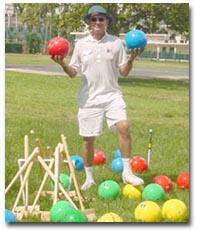
|
| Bob Alman, aka "Mr. Wicket", poses at Palm Beach Rec and Park headquarters with components of the 16-player "Universal X-Treme Game Set," the equipment recommended to cities and counties for their activity centers and recreation programs. Palm Beach and other cities have bought these mega-sets, along with the counties of Palm Beach and Broward, to use in their After-School programs. |
"Mr. Wicket, itís so hot, can I go under the tree now?"
"Mr. Wicket," (pointing), "Those boys are cheating!"
"Is Mr. Wicket your real name?"
"Can I have one of those balls to take home, Mr. Wicket?"
"This is a really cool game, Mr. Wicket!"
When you start down the Long and Winding Road of Development with a pure heart and an open mind, you never know what youíre going to find just around the next bend - much less 20 years down that road. You might find, for example, hordes of Summer Camp kids playing X-treme Malletball in midsummer in South Florida and calling you by the title inscribed in Harrington bold italic on your nametag: "Mr. Wicket."
Actually, itís more than 20 years since I undertook the re-organization of the San Francisco Club explicitly as a development model for the croquet world. It wasnít my original intention, by the way. I started out working on just the San Francisco Club. But early on, I found out that to do the job thoroughly would take a lot of time, and thoroughly is the only way I wanted to do it. So there was no choice but to make the declaration to myself and to the other volunteers working in common cause that we were doing this not just to find out how to make the SFCC succeed, but to discover what would make croquet succeed everywhere.
If I had known 20 years ago how little progress the croquet establishment would make in that time - and with my help! - would I have gone down this road? Maybe not, but the question is moot: The plain fact is, this is where the road of development has led me, and thereís no turning back.
But looking back, in hindsight, the route to where we are now is very clear. From my personal perspective, it goes something like this:
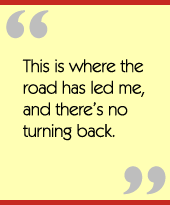
(1) In the mid-eighties, the San Francisco Croquet Club was an early champion of Golf Croquet - which, however, was not highly regarded by most USCA players then, including the high-handicappers. Around the country, there were a few other promoters of the game as a strategy for building the sport, but they didnít get much agreement from their members.
(2) In the early nineties, the Egyptians were brought into the World Croquet Federation, and by the mid-nineties; the excellence of their play helped to raise the stock of Golf Croquet around the world.
(3) By the mid-90ís, the World Wide Web was coming into its own, and the techies in the SFCC club convinced me that we should have a website. This quickly became the USCA website, and later the online magazine, CroquetWorld.com. (And much later, CroquetNational.com. And finally, Malletball.com.)
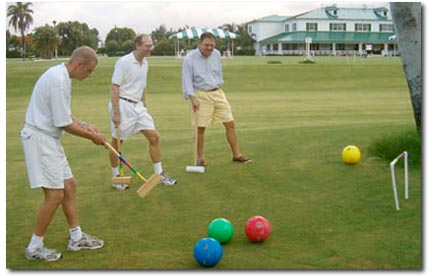
|
| Mike Jenner, CEO of the National Croquet Center, plays malletball at a "Fun & Games" membership event on the Center's Harpo Marx lawn. The super-sized game is also offered to corporate clients and private parties, along with standard Golf Croquet. |
At first glance - even at second glance - it looks like a pretty good overall foundation for development. But get this: None of it has made a noticeable difference. As measured by USCA membership, no progress has been made in the United States in all that time. (In fact, USCA membership declined last year.)
I commented on this to Dan Mahoney, former president of the USCA and one of the nicest guys in the world. He said, "Maybe it did make a difference, Bob. Wouldnít we be a lot worse off if you hadnít done all that?"
Maybe thatís true, but itís hardly encouraging. The numbers look like a dead end on this long road of development. Maybe the pessimists who said, "Croquet will always be a small and struggling sport" were right again. But then, out of nowhere (Well, actually out of Indiana) a goofy game appeared on the horizon that calls the unexamined assumptions into question and opened up new vistas. It could just be that we have a fifth milestone in this incomplete history, namely:
(5) Malletball and Toequet - super-sized X-Treme wicketsports that enable croquet to be played on virtually any outdoor surface, by virtually anyone and everyone - games that instantly communicate the sheer fun and bold spirit of wicket sports.
The unexamined assumption: one size fits all
The main assumption that had never been questioned was about the equipment itself. The focus in croquetís growth had always been to find or create lawns where the conventionally scaled equipment could be used to play a satisfactory game of croquet. Nobody - but NOBODY - had ever proposed that instead of building expensive lawns, you should just super-size the equipment so the games could be played anywhere.
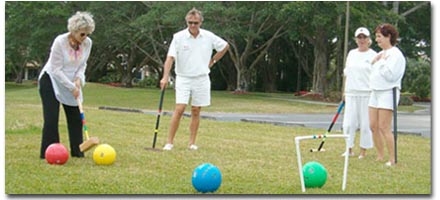
|
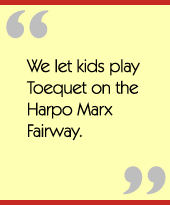
Months later, when my Palm Beach friend John Ryan was helping me put away some equipment after a college group had played Toequet, we started hitting the soccer balls with our regulation mallets, and we noticed that the mallets and balls worked pretty well together. On impulse, we played a game of Golf Croquet not by kicking, but with our mallets, and we had fun. After our one game, we named it on the spot: the game was obviously Malletball!
With the invention - or should I say the "discovery"? - of Malletball, my life changed. Not all of a sudden, but gradually. Malletball provided a new perspective on the problem of development. Toequet was invented to make it possible to play croquet on bad lawns - thus making the game potentially accessibility to millions of people. Exactly the same thing could happen with Malletball. We quickly saw that Malletball was actually a better game on long grass than on short, fast turf. The soccer balls seemed to float right over the shag and the bumps. Malletball could be played in any park, in any grove of trees, through open country, even on the beach! Malletball was much more playable on "found" surfaces than X-treme Croquet.
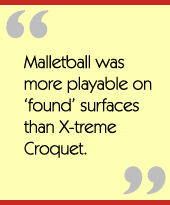
From this new perspective, the Long and Winding Road of Development seemed to straighten out, broaden, and become a virtual freeway. It was now clear that what was stopping the development of croquet was......ACCESS!
Without rehashing all the reasons croquet isnít more popular and more accepted, itís possible to sum it all up in a single abstraction: The organizers of croquet have not made croquet widely available. We have limited access to private clubs and resorts; we have limited participation by impenetrably difficult rules, tactics, and strategy; we have devised games that can be well played only on specialty surfaces expensive to build and maintain. Most of all, we have failed to let the public know that our games are FUN. All of those conditions combine to severely limit access to the sport.
Is it really okay to have fun with croquet?
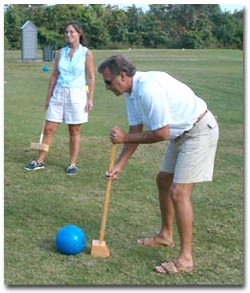
|
| David Osieki, developer and co-owner of Cobblestone Golf and Country Club, bought Malletball equipment as an alternative to golf for the more than 50 percent of his residents who don't play golf. He wields the "Monster" mallet, designed especially for golfers, enabling a power drive using the side-stance golf stroke, with a lifting face on one side to surmount obstacles and soar above shaggy turf towards a distant wicket. |
I never like being called one of "you people", but I got the point. He came to the National Croquet Center with his daughter and played Golf Croquet and Malletball all afternoon. Then he bought two $300.00 four-player croquet sets (to play on his practice green) and two Malletball sets to set up in a pine grove adjacent to the first tee at his golf development. "Because," he said, "only half the people who live around my golf course play golf or tennis." As he left with the equipment, my final advice to him was, "Donít give them the rules to anything but Golf Croquet."
For me, the first half of 2004 was largely about exploring the potential of Malletball. I have worked with the inventors of Toequet to develop and refine the equipment and accessories and to completely retool the website with website designer Reuben Edwardsí considerable help: Malletball.com. The rules of Golf Croquet have remained intact, although the course has changed radically.
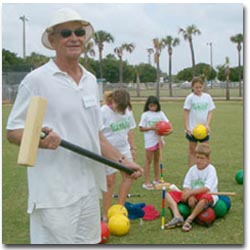
|
| Mr. Wicket is relaxed and happy, because the games are in hour two, and they're running themselves. The children in the background have returned to the center stake after their game to be assigned another game. Usually winners play winners and losers play losers, so the kids get plenty of peer-level play. |
In the last year, I have directed dozens of groups, learning valuable lessons from almost every group. (I currently direct about two groups a week.) The groups are as diverse as charity fund-raisers, singles clubs, neighborhood associations, corporate team-builders...and Spring and Summer Camps for children and teenagers.
Which brings me to back to "Mr. Wicket." On impulse, I put "Mr. Wicket" on my nametag for one of the first Spring Camps I conducted, for a group of about thirty 8- to 12-year-olds at a Christian school in West Palm Beach. Naturally, I was wearing all white and topped by my big, broad-brimmed white safari hat. Thatís when I was asked sweetly by an eight-year-old girl, "Are you an angel, Mr. Wicket?"
"No," I said, "angels have a lot of gold trim on their white clothes, and as you can see, Iím just plain white." The humor was too subtle and too adult, so I quickly corrected myself by saying, "Actually, you never know what color clothes an angel is going to be wearing." She accepted the answer matter-of-factly.

Thatís the day I became "Mr. Wicket," and the name seems to work. It conveys a spirit of fun. A newspaper in Boulder, Colorado, put more than a touch of whimsy into the headline of its Malletball story: "Croquet goes down the rabbitís hole."
I started playing croquet as a child, with my grandmother in the back yard - whom I could never beat. But it was fun. Croquet has always been fun for me, even on those rare occasions when I was winning tournaments. I try to make sure that malletball is fun for everyone in my groups.
So this is where the Long and Winding Road of Development has led me: All the way from my 30-year home in San Francisco to the opposite coast, in South Florida, with a new and not-all-that dignified public persona right out of "Alice in Wonderland."

When I go to lunch after an event "in costume," I canít help noticing that Mr. Wicket is a popular figure around town, approaching the level of a minor celebrity. People smilingly call, "Hello, Mr. Wicket!" open doors for him, tell him they saw his picture in the paper. They seem to instantly like him and relate to him. Itís obvious heís about the fun of the game, so itís not surprising heís so well received. I find that I really like being in his skin from time to time - being "on stage" as Mr. Wicket.
When I take off my camp director outfit, I am still willing to learn from the example of Mr. Wicket. He makes the game really accessible - with rules that are easy and fun; with equipment that can be set up just about anywhere; and most of all, with a light touch and a spirit of fun.
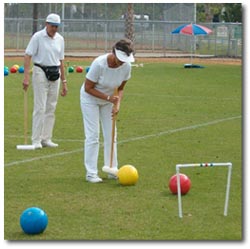
|
| Dick and Mary Knapp of England take some practice shots before an adult demonstration with Mr. Wicket for the Palm Beach County School District. Mr. Wicket is fortunate to have available expert assistance for large events. The more expert teachers, the better the event. Typically, the recreation directors themselves help with the groups and do well, because they're trained to handle groups and they quickly grasp the rules. |
I canít prove it, but Iím betting that our Long and Winding Road of Development could actually straighten out into a broad avenue of welcome to one and all - if only we organizers and promoters refuse to be diverted and keep focused on the most important objective: communicating the fun of the game.
I have gone through the obstacle course that makes me a "Certified After School Director" in Palm Beach County. In the 28 gigs contracted so far, that spirit of fun will be the foundation of an organized curriculum unfolding over many sessions in each of the schools that has hired me to conduct X-treme Wicketsports instruction and games. I insisted on a series of at least five sessions in each school, providing an opportunity for progressive learning in shot-making, strategy, and teamwork - an advantage I didnít have in the many Spring and Summer Camps I conducted.
After-School Malletball could open doors to the school curriculum
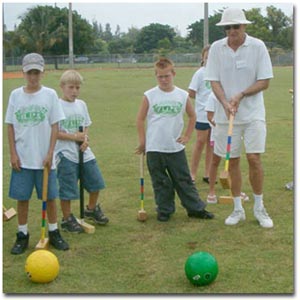
|
| Mr. Wicket shows a summer camper how to use the mallet without hurting himself or wreaking mayhem. Mr. Wicket recommends that no children under 11 years of age be allowed to use these potentially dangerous weapons, and only with strict supervision. Explaining the simple rules of the game is easy, so long as you know that you're going to have to say everything 10 times. Mr. Wicket makes it short an snappy, because he knows that once the kids see those balls, they can hardly wait to hit one. Especially the boys. |
Concurrent with the After-School programs Iíll conduct in the fall are employee picnics and neighborhood and condo association gatherings; then come the hotel-based corporate parties and incentive travel groups of the high season; and the charities who need a new and different focus for their elegant fund-raisers, and the civic and social clubs who are looking for a fun activity that everyone can do, anywhere, anytime....
Itís too soon to say what will become of these development experiments, but from where I stand here in Palm Beach in the middle of 2004, the road looks wide open and clear. Iím assuming I can go anywhere with Malletball and Toequet until I reach a roadblock that, so far, is nowhere in sight.
The only problem is, I can only cover South Florida. When clubs and individual entrepreneurs in other regions see how they can produce revenue with the almost infinitely greater market access this new super-sized equipment provides, I hope they will join me on this road.
Bob Alman is editor of the websites Malletball.com, CroquetAmerica.com, CroquetWorld.com, and CroquetNational.com. He is owner and manager of WicketSports Unlimited, with offices at the National Croquet Center in West Palm Beach, Florida. As Marketing and Development Director of The Toequet Company, he is beginning to recruit "Area Representatives" around the country to duplicate locally the revenue-producing wicketsports programs he is pioneering in South Florida. His email address is: BobAlman@aol.com.